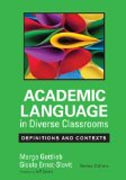
Academic Language in Diverse Classrooms: Definitions and Contexts
Gottlieb, Margo
Ernst-Slavit, Gisela
This companion (foundational) book to the six-book series, Academic Language Demands for Language Learners: From Text to Context, encapsulates the broad ideas of the series by presenting the evolving theory behind the construct of academic language, a definition and examples of each of its components, and a template for direct classroom applicability. Each of the six books in the series is a more detailed, comprehensive treatment of text-based academic language at each grade level and describes the process by which teachers can incorporate academic language into their instructional assessment practices. This foundations book is suitable for use with any (or all) of the six volumes or can be used separately. INDICE: ForewordPrefaceAcknowledgementsAbout the AuthorsIn the Beginning….1. What is Academic Language? The Role of Language in Schooling and Beyond Different Registers The Nature of Academic Language Evolving Perspectives of Academic Language Academic Language Versus Social Language Perspectives Systemic Functional Linguistic Perspectives Language Skills Perspectives Sociocultural Perspectives Language as Action Perspectives Academic Language Learning as a Developmental Process Considerations for Students with Disabilities Oral and Written Languages Oral Language as a Vehicle for Promoting Academic Language Development Oral Language as a Bridge to Literacy Multiliteracies and Multimodalities as Sources of Academic Language Raising Awareness of Academic Language Academic Language and Social Justice For Further Thinking2. What Are the Dimensions of Academic Language? Identifying Academic Language Within and Across Content Areas Analyzing Academic Language Within Discourse Balance Between Informational and Literary Texts Differences Between Nonfiction and Informational Texts Examining Sentence-Level Structures Language Functions as Expressions of Sentence-Level Meaning Identifying Vocabulary--Words, Phrases, and Expressions Development of Academic Vocabulary Teaching Academic Vocabulary in Authentic Contexts Through Meaningful Interactions Vocabulary Instruction for English Language Learners For Further Thinking3. How Do Standards Define and Shape Academic Language Use? The Impact of the New Standards on Shaping Academic Language Bringing Standards Together: Content Learning Through Language and Language Learning Through Content Content and Language Learning for English Language Learners The Impact of Standards in Shaping Grade-Level Language for Academic Purposes Academic Language Within Content Standards Resources for ELLs for the New Content Standards Examples of Academic Language in Content Standards Academic Language in English Language Development/Proficiency Standards Academic Language Use in Language Standards The Impact of Home Language on Academic Language Development Suggestions for Redefining Teaching and Learning Around Academic Language Use For Further Thinking4. How is Academic Language Used in Content Areas Schoolwide? Seeing Academic Language Throughout the School Day Listening in the Music Classroom Moving From a Physical Education Class to the Arts Looking Into Mathematics Classrooms Entering an English Language Arts Class Visiting a Science Class The Language of Science Textbooks Exploring Academic Language in a Social Studies Class The Specialized Language of Social Studies Texts Effective Instruction in Content Classrooms Around a Unit of Learning For Further Thinking5. How Can Academic Language Be Integrated Into Instruction and Assessment? Maintaining a Focus on Academic Language: A Historical Perspective Planning a Unit of Learning Around Academic Language Use Capitalizing on Linguistic and Cultural Resources Deciding on a Theme for a Unit of Learning Matching the Theme to Standards Academic Language Use in Learning Targets and Differentiated Objectives Infusing Academic Language Into Unit Targets and Differentiated Lesson Objectives Instructional Activities and Tasks The Relationship Between Assessment and Instruction Placement of Assessment Within a Curricular Framework Assessment Across Lessons of a Unit: Measuring Standards and Learning Targets Assessment Within Lessons: Measuring Differentiated Objectives Crafting Instructional Activities and Tasks Reflecting on Teaching and Learning Teacher Reflection Student Reflection For Further Thinking6. How is Academic Language Situated in Curricular Design and Infused Into Professional Learning? A Theoretical Basis for Curricular Frameworks Early Thinking on Curriculum Recent Thinking on Curriculum Conceptual Frameworks That Integrate Language and Content The Value of an Integrated Curricular Framework for Diverse Schools and Districts A Curricular Framework That Features Academic Language Use The Role of Professional Learning in Understanding and Promoting Academic Language Use Implementing Professional Learning: From Two Participants to District Level Participation Making School a Meaningful Experience for 21st Century Students Culturally and Linguistically Responsive Teaching and Learning Transformation of Schools Promoting Academic Language for All Students and Teachers Seeking Advocacy Within the Educational Community For Further ThinkingAt the End….ResourcesA. CCSS for Mathematics and Related Academic LanguageB. Examples from the CCSS for English Language Arts of Related Academic LanguageC. A Curricular Framework Highlighting Academic LanguageGlossaryReferencesIndex
- ISBN: 978-1-4522-3478-6
- Editorial: Corwin
- Encuadernacion: Rústica
- Páginas: 256
- Fecha Publicación: 30/06/2014
- Nº Volúmenes: 1
- Idioma:
